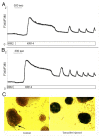Characterization of mice expressing Ins1 gene promoter driven CreERT recombinase for conditional gene deletion in pancreatic β-cells
- PMID: 25483876
- PMCID: PMC4114654
- DOI: 10.4161/isl.27685
Characterization of mice expressing Ins1 gene promoter driven CreERT recombinase for conditional gene deletion in pancreatic β-cells
Abstract
Gene manipulation using Cre-loxP recombination has proven to be an important approach for studying the impact of gene expression on pancreatic β-cell biology. We report the generation of a transgenic mouse line that enables a highly specific system for conditional gene manipulation within β-cells and achieve tissue specific and temporally regulated deletion of the Ctnnb1 (β-catenin) gene in pancreatic β-cells. cDNA encoding Cre recombinase fused to modified estrogen receptor (CreERT) under control of mouse insulin 1 gene promoter (Ins1) was used to construct the mouse line Tg(Ins1-Cre/ERT)1Lphi, also termed MIP1-CreERT. In a cross of MIP1-CreERT with a ROSA26/LacZ reporter strain, tamoxifen [Tmx] - dependent β-galactosidase expression occurred within pancreatic β-cells but not in other organ systems. Intraperitoneal glucose tolerance tests and glucose-stimulated changes in β-cell cytoplasmic calcium concentration were not adversely affected in adult MIP1-CreERT. A mouse line with floxed Ctnnb1 gene (Ctnnb1f/f) was crossed with the MIP1-CreERT line to generate a mouse model for inducible β-cell specific deletion of β-catenin gene (Ctnnb1f/f:MIP1-CreERT). Ctnnb1f/f:MIP1-CreERT mice and Ctnnb1f/f littermate controls, were injected with Tmx as adults to knock down β-catenin production in the majority of pancreatic β-cells. These mice showed normal glucose tolerance, islet cyto-architecture and insulin secretion. A novel protein fraction of 50Kd, immunoreactive with anti-β-catenin was observed in islet extracts from Ctnnb1f/f:MIP1-CreERT[Tmx] mice but not MIP1-CreERT-negative Ctnnb1f/f[Tmx] controls, indicating possible presence of a cryptic protein product of recombined Ctnnb1 gene. The MIP1-CreERT mouse line is a powerful tool for conditional manipulation of gene expression in β-cells.
Keywords: Cre recombinase; Ins1 gene promoter; calcium; glucose tolerance; insulin secretion; pancreatic islet; β-catenin.
Figures







Similar articles
-
Generation and Characterization of Transgenic Mice Expressing Mouse Ins1 Promoter for Pancreatic β-Cell-Specific Gene Overexpression and Knockout.Endocrinology. 2015 Jul;156(7):2724-31. doi: 10.1210/en.2015-1104. Epub 2015 Apr 17. Endocrinology. 2015. PMID: 25885930
-
Generation and characterization of Ins1-cre-driver C57BL/6N for exclusive pancreatic beta cell-specific Cre-loxP recombination.Exp Anim. 2014;63(2):183-91. doi: 10.1538/expanim.63.183. Exp Anim. 2014. PMID: 24770644 Free PMC article.
-
Transgenic mice exhibiting inducible and spontaneous Cre activities driven by a bovine keratin 5 promoter that can be used for the conditional analysis of basal epithelial cells in multiple organs.J Biomed Sci. 2009 Jan 8;16(1):2. doi: 10.1186/1423-0127-16-2. J Biomed Sci. 2009. PMID: 19272176 Free PMC article.
-
A practical guide to genetic engineering of pancreatic β-cells in vivo: getting a grip on RIP and MIP.Islets. 2014;6(3):e944439. doi: 10.4161/19382014.2014.944439. Islets. 2014. PMID: 25322827 Free PMC article. Review.
-
The Cre-loxP system: a versatile tool for targeting genes in a cell- and stage-specific manner.Cell Transplant. 2000 Nov-Dec;9(6):805-15. doi: 10.1177/096368970000900607. Cell Transplant. 2000. PMID: 11202567 Review.
Cited by
-
Differential Insulin Secretion of High-Fat Diet-Fed C57BL/6NN and C57BL/6NJ Mice: Implications of Mixed Genetic Background in Metabolic Studies.PLoS One. 2016 Jul 12;11(7):e0159165. doi: 10.1371/journal.pone.0159165. eCollection 2016. PLoS One. 2016. PMID: 27403868 Free PMC article.
-
Dynamin 2 regulates biphasic insulin secretion and plasma glucose homeostasis.J Clin Invest. 2015 Nov 2;125(11):4026-41. doi: 10.1172/JCI80652. Epub 2015 Sep 28. J Clin Invest. 2015. PMID: 26413867 Free PMC article.
-
Disrupted RNA editing in beta cells mimics early-stage type 1 diabetes.Cell Metab. 2024 Jan 2;36(1):48-61.e6. doi: 10.1016/j.cmet.2023.11.011. Epub 2023 Dec 20. Cell Metab. 2024. PMID: 38128529 Free PMC article.
-
Sox9 regulates alternative splicing and pancreatic beta cell function.Nat Commun. 2024 Jan 18;15(1):588. doi: 10.1038/s41467-023-44384-8. Nat Commun. 2024. PMID: 38238288 Free PMC article.
-
The Pdx1-Bound Swi/Snf Chromatin Remodeling Complex Regulates Pancreatic Progenitor Cell Proliferation and Mature Islet β-Cell Function.Diabetes. 2019 Sep;68(9):1806-1818. doi: 10.2337/db19-0349. Epub 2019 Jun 14. Diabetes. 2019. PMID: 31201281 Free PMC article.
References
-
- Postic C, Shiota M, Niswender KD, Jetton TL, Chen Y, Moates JM, Shelton KD, Lindner J, Cherrington AD, Magnuson MA. Dual roles for glucokinase in glucose homeostasis as determined by liver and pancreatic beta cell-specific gene knock-outs using Cre recombinase. J Biol Chem. 1999;274:305–15. doi: 10.1074/jbc.274.1.305. - DOI - PubMed
-
- Gu G, Dubauskaite J, Melton DA. Direct evidence for the pancreatic lineage: NGN3+ cells are islet progenitors and are distinct from duct progenitors. Development. 2002;129:2447–57. - PubMed
-
- Wiebe PO, Kormish JD, Roper VT, Fujitani Y, Alston NI, Zaret KS, Wright CV, Stein RW, Gannon M. Ptf1a binds to and activates area III, a highly conserved region of the Pdx1 promoter that mediates early pancreas-wide Pdx1 expression. Mol Cell Biol. 2007;27:4093–104. doi: 10.1128/MCB.01978-06. - DOI - PMC - PubMed
Publication types
MeSH terms
Substances
Grants and funding
LinkOut - more resources
Full Text Sources
Other Literature Sources
Medical
Molecular Biology Databases
Miscellaneous
